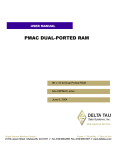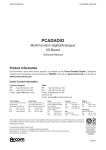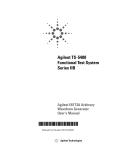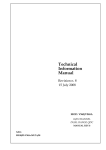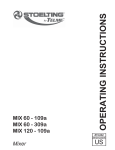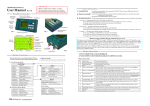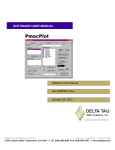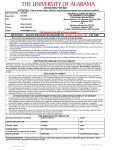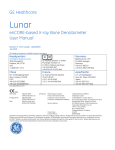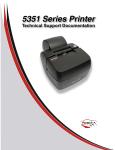Download ^2 PMAC DUAL PORTED RAM
Transcript
^1 USER MANUAL ^2 PMAC DUAL PORTED RAM ^3 8K x 16 bit dual-ported RAM ^4 3Ax-00PMAC-xUxx ^5 January 30, 2003 Single Source Machine Control Power // Flexibility // Ease of Use 21314 Lassen Street Chatsworth, CA 91311 // Tel. (818) 998-2095 Fax. (818) 998-7807 // www.deltatau.com Copyright Information © 2003 Delta Tau Data Systems, Inc. All rights reserved. This document is furnished for the customers of Delta Tau Data Systems, Inc. Other uses are unauthorized without written permission of Delta Tau Data Systems, Inc. Information contained in this manual may be updated from time-to-time due to product improvements, etc., and may not conform in every respect to former issues. To report errors or inconsistencies, call or email: Delta Tau Data Systems, Inc. Technical Support Phone: (818) 717-5656 Fax: (818) 998-7807 Email: [email protected] Website: http://www.deltatau.com Operating Conditions All Delta Tau Data Systems, Inc. motion controller products, accessories, and amplifiers contain static sensitive components that can be damaged by incorrect handling. When installing or handling Delta Tau Data Systems, Inc. products, avoid contact with highly insulated materials. Only qualified personnel should be allowed to handle this equipment. In the case of industrial applications, we expect our products to be protected from hazardous or conductive materials and/or environments that could cause harm to the controller by damaging components or causing electrical shorts. When our products are used in an industrial environment, install them into an industrial electrical cabinet or industrial PC to protect them from excessive or corrosive moisture, abnormal ambient temperatures, and conductive materials. If Delta Tau Data Systems, Inc. products are exposed to hazardous or conductive materials and/or environments, we cannot guarantee their operation. PMAC Dual-Ported RAM User Manual Table of Contents DUAL-PORTED RAM COMMUNICATIONS........................................................................................................1 Uses of DPRAM........................................................................................................................................................1 Setting up The PCbus Dual Ported RAM (Option 2) ................................................................................................1 Software Setup ......................................................................................................................................................2 System Memory Map (most compatible)...............................................................................................................3 Starting Address....................................................................................................................................................3 Setting up the VME Dual-Ported RAM (Option 2V)................................................................................................5 Starting Address....................................................................................................................................................5 Using the Dual Ported RAM (PC and VME) ............................................................................................................7 DUAL-PORTED RAM AUTOMATIC FUNCTIONS.............................................................................................1 DPRAM Data Format................................................................................................................................................1 Control Panel Function..............................................................................................................................................2 General Description .............................................................................................................................................2 Register Addresses................................................................................................................................................3 Control Panel Request Words...............................................................................................................................3 Bit Format of Request Words................................................................................................................................3 Servo Fixed Data Buffer............................................................................................................................................4 General Description .............................................................................................................................................4 Register Map.........................................................................................................................................................5 Background Fixed Data Buffer .................................................................................................................................7 General Description .............................................................................................................................................7 Register Map.........................................................................................................................................................7 Background Variable Data Read Buffer..................................................................................................................11 General Description ...........................................................................................................................................11 Enabling..............................................................................................................................................................12 Single User Mode Procedure..............................................................................................................................12 Multi-User Mode Procedure...............................................................................................................................12 Data Format .......................................................................................................................................................13 Disabling ............................................................................................................................................................13 Register Map.......................................................................................................................................................13 Background Variable Data Write Buffer.................................................................................................................14 General Description ...........................................................................................................................................14 Enabling..............................................................................................................................................................14 Procedure ...........................................................................................................................................................14 Data Format .......................................................................................................................................................15 Disabling ............................................................................................................................................................15 Register Map.......................................................................................................................................................15 DPRAM Data Gathering Buffer..............................................................................................................................16 DPRAM ASCII Communications ...........................................................................................................................17 General Description ...........................................................................................................................................17 Read/Write Procedure ........................................................................................................................................17 Interrupts ............................................................................................................................................................18 Register Map.......................................................................................................................................................19 Binary Rotary Program Buffers...............................................................................................................................20 General Description ...........................................................................................................................................20 Register Map.......................................................................................................................................................21 Binary Command Structure ................................................................................................................................21 Internal PMAC 48-Bit Command Format ..........................................................................................................23 Table of Contents i PMAC Dual-Ported RAM User Manual ii Table of Contents PMAC Dual-Ported RAM User Manual DUAL-PORTED RAM COMMUNICATIONS PMAC’s Option 2 provides an 8K x 16 bit dual-ported RAM that allows PMAC and its host to share an area of fast memory. For the PMAC-PC and the PMAC-Lite, Option 2 is a separate board that sits on the PC bus and cables to PMAC. For the PMAC-VME, Option 2(V) consists of ICs added to the main board itself. Option 2 is not available for the PMAC-STD. For all versions of the PMAC2, Option 2 consists of ICs added to the main board itself. The dual-ported RAM can be used for extremely fast communication of data and commands to and from PMAC. Uses of DPRAM The typical use in writing to PMAC is for a very fast repetitive downloading of position data and/or rotary program information in real time. The typical use in reading from PMAC is getting very fast status information repetitively. PMAC supports both automatic functions for the DPRAM communications, and user-designated functions. Data such as motor status, position, velocity, following error, etc. can be continuously updated and written to DPRAM by PLC programs or automatically by PMAC. Without using DPRAM, this data must be accessed by sending PMAC on-line commands, such as ?, P, V, and F, through the VME mailbox registers or over the PCbus. This same data may be obtained much faster via the DPRAM without the time required to send the command through the communications port and wait for the response. For non-automatic uses, PMAC usually accesses the dual-ported RAM through M-variables that are addressed to these locations. This can work for reading or writing. The M-variable formats likely to be used are X:, Y: (for 1 to 16 bits), DP: (for 32-bit fixed point), and F: (32-bit floating point). For sending data back to the host, PMAC's data gathering function can also be used, directed to the dual-ported RAM rather than the regular RAM (I45 controls). See the Analysis Features section of the PMAC manual for details. Setting up The PCbus Dual Ported RAM (Option 2) There is no hardware setup or connections for the Option 2 DPRAM on the PMAC2-PC or PMAC2-Lite. It is factory installed on the PMAC2 itself. For the PMAC(1) PCbus cards, the DPRAM card plugs into an available PC-slot to the right side of your PMAC-PC or Lite card. The PMAC and DPRAM card together occupy 2 PC slots. The two short cables provided connect the DPRAM to the CPU on the PMAC. The 50 pin cable connects P3 of DPRAM to J2 of PMAC (piggy-back board) or J9 of PMAC-Lite. The 10 pin cable connects P4 of DPRAM to J4 of PMAC (piggy-back board) or J10 of PMAC-Lite. Dual-Ported RAM Communications 1 PMAC Dual-Ported RAM User Manual PMAC-PC OPTION 2 DUAL-PORTED RAM INTERFACE BOARD 4.19 in (106.4 mm) P4 U10 3.88 in (98.5 MM) P3 7.50 in (190.5 mm) To install the board, connect the cables as previously stated with the boards removed from your computer. Next, install both boards, plugging in PMAC first and then the DPRAM board in the slot next to it. Turn on your computer and establish communication with PMAC using the PMAC Executive software. At the time of this manual revision, the easiest method of configuring the Dual Ported RAM is using the Executive Program. There are only two hardware configurations (set with jumper E1) for the DPRAM card. Jumper E1 controls whether the DPRAM uses 8 or 16-bit access. E1 should be removed for 8-bit access in a 16-bit PCbus (AT) slot. Install E1 for 16-bit operation (faster data transfers). All other DPRAM configurations are done entirely through software programming via PMAC. Software Setup The software setup is simply a matter of setting a few register values in PMAC through the normal bus communications port, and saving these values to non-volatile memory. This should allow the host computer to have direct access to this memory in an open area of its memory space. Once the setup has been made successfully, the DPRAM registers can be accessed from the PC side with pointer variables. The configuration of the DPRAM is done entirely through software. Configuring consist of selecting an 16K block (byte addressing) of unused memory space in your PC. This is not necessarily a trivial task. Depending on your computer and other accessory cards you may have (such as network cards, graphic cards, etc. that use conventional memory space and not I/O memory space), your available memory space location may vary. You may think of it as adding a standard memory card to your computer where you must select an address location in the memory map that no other device in your computer uses. If you are unsure about the locations available for DPRAM to use there is menu option Configure|PC Dual Ported RAM under the Configure menu in the PMAC Executive Program which can help you find an available block of memory space. Please refer to the PMAC Executive Program Manual for details on how to do this. In most cases the available memory space will be found between locations $B0000 and $EC000. Usually a system memory map of the PC which is standard for most PC’s and compatibles is found below. 2 Dual-Ported RAM Communications PMAC Dual-Ported RAM User Manual System Memory Map (most compatible) Decimal Hex 0 16K 32K 48K 64K 0000 04000 08000 0C000 10000 ⋅ ⋅ ⋅ ⋅ ⋅ ⋅ 624K 640K 9C000 A0000 ⋅ ⋅ 688K 704K AC000 B0000 ⋅ ⋅ ⋅ ⋅ 944K 960K EC000 F0000 ⋅ ⋅ 1008K FC000 Function Standard 640K RAM for DOS, Programs, etc. Usually VGA/EGA Space Recommended memory space monochrome may start at B0000 System BIOS & ROM Starting Address Once you have chosen a used block of memory space, you must now configure the DPRAM to start at that address. To do this, you must write the segment value (8 highest order bits) of your chosen start address into locations $786 and $787 of PMAC’s ‘X’ memory (see I/O Memory Map section of PMAC’s Users Manual). These are special memory locations in PMAC which tell PMAC where in PC memory to locate the DPRAM. In addition, you also specify using the 20 or 24-bit DPRAM addressing mode. The 24-bit addressing mode allows you to locate your DPRAM above the 1 megabyte range (locations above $FFFFF). (If you have an 8086 or an 8088 microprocessor (IBM PC/XT), you may only use 20-bit addressing and are limited to configuring the DPRAM for locations $FC000 and under). In most cases, no matter which microprocessor you have (AT, XT, or whatever), locating your DPRAM between $B0000 and $EC000 will be sufficient. Note: Most users will simply use the Configure|PC Dual Ported Ram window in the PMAC Executive program to set the address for DPRAM. The following section explains how to perform this setup without the Executive program. The PMAC Executive program Configure|PC Dual Ported RAM screen specifies PC memory addresses in terms of memory "segments". Each memory segment starts 16 addresses from the pervious segment, so the segment address is like the memory address without the hex digit (i.e. memory address $D4000 is segment address $D400). Bits 0-3 (first four least significant bits) of PMAC location X:$787 as follows: Bit 0: DPRAM enable/disable (1=enable, 0=disable) Bit 1: 8K RAM (0=8K) Bit 2: 24-bit/20 bit addressing enable (1=24 bit, 0=20 bit) Dual-Ported RAM Communications 3 PMAC Dual-Ported RAM User Manual Example: Suppose you wanted to configure your DPRAM to start at $EC000 in PC memory. You have 8K of DPRAM and you want 24-bit addressing. To configure and enable your DPRAM, you could either use the PMAC Executive program’s Dual Port RAM configuration feature or send the following commands directly to PMAC. WX:$786,$0000E,$000C5 ;Configure DPRAM for $EC000 save ;save configuration to EAROM $$$ ;reinitialize the card The last hex digit 5 comes from the above binary number 0101 = $5 Unused 24-bit Addr. 8K RAM Enabled To disable the DPRAM, you could use the PMAC Executive program’s dual Port RAM configuration feature or send the following commands directly to PMAC. WX:$786,$0000E,$000C4 save $$$ ;disable DPRAM! ;save configuration to EAROM ;reinitialize the card VME and/or DPRAM Address Setup Normal Setup Procedure Default values in PMAC PROM Non-volatile Storage Registers in PMAC EEPROM 1. Send values from setup computer to PMAC User interface registers 2. SAVE values to PMAC EEPROM 3. Reset PMAC to copy values into active control registers Reset with Re-initialize (E51 ON or $$$***) SAVE Normal Reset User Interface Registers in PMAC RAM Any Reset Active Interface Control Registers PMAC (VME) RHX$783,10 (PC) RHX$786,2 WX$783, ... (VME) WX$786, ... (PC) Setup Computer 4 Dual-Ported RAM Communications PMAC Dual-Ported RAM User Manual Setting up the VME Dual-Ported RAM (Option 2V) There is no hardware setup or connections for the Option 2V DPRAM on the PMAC-VME or PMAC2VME. It is factory installed on the PMAC board itself. Starting Address Before you can communicate with PMAC-VME through the DPRAM, you must setup its starting address. Initial communications to the VME for setup of the address of the VME mailbox registers is done over the serial port. The setup of the DPRAM address can be done either with or after the mailbox setup (see Writing a Host Communications Program in the PMAC User's Manual). Before choosing the DPRAM starting address, you must determine what memory space is available in your VME system (so that PMAC's DPRAM does not interfere with existing RAM or other devices on your VMEbus). Just like setting up the base address of PMAC-VME, the starting address of DPRAM is done through software, but in a somewhat different manner. The best way to describe how to setup DPRAM is to give an example. Note: Most users will simply use the Configure|VME Communications window in the PMAC Executive program to set the address for DPRAM. The following section explains how to perform this setup without the Executive program. Example: Suppose you have selected a starting address of $1FC000 for the DPRAM. Just like we did for the base address of PMAC, it is best to rewrite this address in binary and label the address bits, starting with A0 as the rightmost bit: Address Bit Binary Hex A31 0000 A24 0000 00 A23 0001 A16 1111 1F A15 A8 1100 0000 C0 A7 0000 A0 0000 00 Clearly, we have a value of $00 for address bits A31 - A24, $1F for address bits A23 - A16, $C0 for bits A15 - A8 and $00 for bits A7 - A0. To tell PMAC where we want DPRAM to begin, we need to break up this starting address into 2 parts: 1. 2. The first part will represent the value address bits A23 through A20. This value will only be written to PMAC once during the setup process and saved. The second part will represent the value address bits A19 through A14. This value will need to be written to PMAC each time it is powered up or reset. If you are using 32-bit addressing, address bits A31 through A24 for the dual-ported RAM are determined by PMAC's memory location X:$0785, which is also used for the same address bits of the base address of the mailbox registers. First we have to write the value of address bits A23 through A20 into bits 7 through 4 (high order nibble) of PMAC's memory location X:$078A, i.e. the left hex digit (most significant bits) will be the value of address bits A23 - A20, and the other digit (right digit & least significant bits) will always be $0. In this example, the value for address bits A23 - A20 would be $1, therefore we would write a value of $10 into location X:$078A. Now we have to determine the value of address bits A19 through A14. Every time PMAC is powered up or reset (either with the hardware reset line or use of the $$$ command) we will need to write this value into PMAC's base address + $121 (remember, from our previous examples, PMAC's base address is $7FA000). In this example, constructing a 6-bit hex number from bits A19 - A14 gives us a value of $3F: Dual-Ported RAM Communications 5 PMAC Dual-Ported RAM User Manual Address Bits Binary Hex A19 A18 A17 A16 A15 A14 So we write $3F from the VME host computer (master) into VMEbus location $7FA121 after PMAC is powered up or reset. Note: This dynamic addressing scheme provides the capability for addressing up to 1M byte of DPRAM in 16K byte blocks, by changing the value of base + $121 on the fly. However, PMAC-VME currently utilizes only a single 16 Kbyte block (8K x 16), so the base + $121 register only has to be written to once every time PMAC is powered up or reset. At this point, the starting address of DPRAM is fully specified. However we need to check two more register locations in PMAC's memory for having appropriate values. Location X:$078B must have a value of $E0 to enable the DPRAM chip installed on your PMAC-VME and we must modify the value in location X:$078C (the address width register) by adding $80 to the existing value. For this example, our PMAC register values would be: PMAC Address Value X:$0783 X:$0784 X:$0785 X:$0786 X:$0787 X:$0788 X:$0789 X:$078A X:$078B X:$078C $39 $04 $00 $7F $A0 $02 $A1 $10 $E0 $90 The shaded registers above contain the values we changed (from example 2.0) to enable DPRAM. A simple write command followed by a SAVE command to PMAC will put these values into their appropriate registers and make them permanent: WX$0783,$39,$4,$0,$7F,$A0,$02,$A1,$10,$E0,$90 SAVE Remember that these values must be saved with the SAVE command and then the card reset (with the $$$ command, the INIT/ input line pulled low, or power cycled) before these new values will take effect. After this, writing $3F to $7FA121 (base + $121) will allow us to start using dual ported RAM! 6 Dual-Ported RAM Communications PMAC Dual-Ported RAM User Manual Using the Dual Ported RAM (PC and VME) The mapping of memory addresses between the host computer on one side, and PMAC's address space on the other side, is quite simple. Using this memory is a matter of matching the addresses on both sides. To PMAC, DPRAM simply appears as extra memory in the range $D000 to $DFFF, which can be thought of as 4K of double (48-bit) words or 8K of single (24-bit) words, in both X and Y memory (remember, X and Y memory in PMAC are 24-bit locations!). Note: DPRAM only occupies the low 16 bits (0-15) of each 24-bit word in PMAC. Dual-Ported RAM Communications 7 PMAC Dual-Ported RAM User Manual PMAC memory locations $D000 to $D1FF are reserved for fixed uses. The range of $D200 to $DFFF is open for general-purpose use. From the PMAC side, locations in DPRAM are typically accessed using M-variables. An M-variable is defined to each word to be used (such as M120->X:$D200,0,16,S), then these M-variables are used in programs. They can either be written to (e.g. M120=P1+P5) or read from (e.g., X(M120) or P1=M120). To the host, DPRAM appears as 8K x 16-bit words of memory. Since most computers address by byte, this requires 16K of address space, or 14 bits (214 = 16K) on the host bus. Consecutive 16-bit locations of DPRAM are located at even addresses. That is, address bit A0 (the least significant bit of your DPRAM address) should always be 0. These DPRAM locations are typically accessed through host word read and word write commands. When you access a location in DPRAM, either reading or writing, address bit A1 selects whether you are reading or writing to PMAC's Y or X memory. If address bit A1 = 0, you are selecting the equivalent of PMAC's Y memory. Conversely, if address bit A1 = 1, you are selecting PMAC's X memory. Table 4.1 below shows the DPRAM addresses and the corresponding host address from our previous example: PMAC Address Host Address Y:$D000 X:$D000 Y:$D001 X:$D001 Y:$D200 X:$D200 ..... ..... Y:$DFFF X:$DFFF $1FC000 $1FC002 $1FC004 $1FC006 $1FC800 $1FC802 ..... ..... $1FFFFC $1FFFFE The following two equations can be helpful to help you calculate both PMAC and host addresses for DPRAM: Host address = Host start address + 4 x (PMAC address - $D000) + offset where: offset = 0 for accessing Y memory, and offset = 2 for accessing X memory. In our example, Host start address = $1FC000. In converting the other way, we have: PMAC address = 0.25 x (Host address - Host start address) + $D000 Host DPRAM address bits A2 through A13 select which PMAC word is to be accessed. The value of these bits equals the PMAC equivalent address minus $D000. Read/write Example: Suppose you configured your DPRAM to begin at host location $EC000 and you write to PMAC WY$D000, $1234 WX$D000, $5678 8 Dual-Ported RAM Communications PMAC Dual-Ported RAM User Manual Host Writing to the DPRAM on the host side and reading it through PMAC is just as easy. The alignment of the numbers work the same way as illustrated above. The host application program and the PMAC motion control and/or PLC programs may be written to allow a wide variety of control and data transfer capabilities. While certain DPRAM addresses are reserved as mentioned above, the host may set certain addresses to trigger an operation in the PMAC, the PMAC may set certain addresses to trigger an operation in the host, etc. Programming Examples: Example #1: Suppose you are writing a host program in C to read motor #1’s actual position. You could use the DPRAM automatic features to place this data in DPRAM or you could use a PMAC PLC program. To use a PLC program all you need to do is define two M-variables and a one line PLC program which constantly updates a location in DPRAM. Your C-program can then read this value, which is a 32 bit integer. In PMAC, you would enter the following M-variable definitions and PLC program. M130->D:$28 M131->DP:$D000 ;motor #1 actual position ;point to a location in DPRAM OPEN PLC 1 CLEAR M131=M130/(I108*32) CLOSE ;update motor position (in counts) in DPRAM I5=2 ENABLE PLC 1 ; allow PLC 1 to be enabled ; “turn on” PLC 1 Now, we need to read the location corresponding to M131 ($D000 in PMAC's memory) in PC memory, and extract this position information so that our C program can use it. The corresponding address in PC memory can easily be determined by talking the address location in PMAC’s memory minus the starting address (always $D000), multiply by 4 (because the X and Y words for each location in PMAC’s DPRAM space is equivalent to 4 bytes or locations of PC memory), and add it to the PC memory starting address we selected for the DPRAM. PC Location = ((PMAC Mem. Location (hex)- $D000) × 4) + (PC Mem Starting Address selected for DPRAM) Let’s assume we configured DPRAM to start at PC address $D4000. We want the equivalent PC address location for PMAC location $D200. This would be: Hex: Decimal: ($D200 -$D000) × 4 + $D4000 = $D4800 (53760 - 53248)× 4 + 868352 = 870400 Our C code now only has to PEEK location $D4800 and $D4802 (since we need to get 4 bytes to get a 32 bit word) to obtain motor #1’s current position. Your C code subroutine may look like this. long get_motor_position (){ int hi_word; Dual-Ported RAM Communications 9 PMAC Dual-Ported RAM User Manual unsigned lo_word; lo_word = peek (0xD400, 0x0800); hi_word = peek (0xD400, 0x0802); return (hi_word *65536 +lo_word); Example #2: Suppose you wish to calculate positions for 3 axes in your own C program and have PMAC move to these positions. What you would do is assign three M-variables to point to three DPRAM locations, write position values to these locations with your C program, and have a PMAC motion program use these variables in its move statements. In the sample code below, a flag bit has been used to signal your C program when the data has been taken by PMAC so you can load the next move locations. M101->DP:$D201 M102->DP:$D202 M103->DP:$D100 M100->DP:$D200,0 M104->DP:$D200,1 ; ; ; ; ; ; used for motor x’s commanded position used for motor x’s commanded position used for motor x’s commanded position go flag to stop motion program flag to stop C program when positions have been received OPEN PROG 1 CLEAR TA10 WHILE(M100=1) ;keep looking while go flag is 1 X(M101) Y(M102) Z(M103) ;move x,y,z to new positions ENDWHILE CLOSE Your C program calculates the positions, and would send them to PMAC via a subroutine like this: void update_positions (longx, long y, long z, int stop_program) { static long far *x, *y, *z; x = MK_FP (0xD400, 0x0804); y = MK_FP (0xD400, 0x0808); z = MK_FP (0xD400, 0x080C); while (peek (0xD400, 0x0801) == 1); /* wait until position ; received */ *x = X; *y = Y; *z = Z; poke (0xD400, 0x0801,1); /*send position flag } 10 Dual-Ported RAM Communications PMAC Dual-Ported RAM User Manual DUAL-PORTED RAM AUTOMATIC FUNCTIONS PMAC provides many facilities for using the dual-ported RAM (DPRAM) to pass information back and forth between the host computer and PMAC. These facilities are comprised of the following functions: 1. DPRAM Control Panel Function (Host to PMAC) 2. DPRAM Servo Data Reporting Function (PMAC to Host) 3. DPRAM Background Fixed Data Reporting Function (PMAC to Host) 4. DPRAM Background Variable Data Reporting Function (PMAC to Host) 5. DPRAM ASCII Communications Buffer (Bi-directional) 6. DPRAM Binary Rotary Program Buffer (Host to PMAC) 7. DPRAM Data Gathering Buffer (PMAC to Host -- already existing) 8. DPRAM <CONTROL-W> ASCII Command Function (Host to PMAC -- superseded by DPRAM ASCII Communications) In addition to these "automatic functions", the user is free to access otherwise unused registers in the DPRAM through the use of M-variables on the PMAC side, and through pointer variables on the host side, for sending data either way between the host and PMAC. Each of the automatic functions is described in detail below. Note: In listing memory locations, both the host memory address and the PMAC memory address will be given. The host address is given as an offset from the base address of the DPRAM in the host memory space; it is expressed in standard C-language hexadecimal notation (e.g. 0x1F80). The PMAC address is given in parentheses as an absolute location in PMAC memory; it is expressed in the standard PMAC hexadecimal notation (e.g. X:$D008) DPRAM Data Format Long-format data is stored in the DPRAM in 32-bit sign-extended form. That is, each short (24-bit) from PMAC is sign-extended and stored in 32 bits of DPRAM. The most significant byte is all ones or all zeros, matching bit 23. Each long (48-bit) word is treated as 2 24-bit words, with each short word signextended to 32 bits. The host computer must re-assemble these words into a single value. The data appears in the DPRAM in Intel format: the less significant bytes and words appear in the lower-numbered addresses. To reassemble a long fixed-point word in the host, take the less significant 32-bit word, and mask out the sign extension (top eight bits). In C, this operation could be done with a bit-by- bit AND: (LSW & 16777215). Treat this result as an unsigned integer. Next, take the more significant word and multiply it by 16,777,216. Finally, add the two intermediate results together. To reassemble a long floating-point word in the host, treat the less significant word the same as for the fixed-point case above. Take the bottom 12 bits of the more significant word (MSW & 4095), multiply by 16,777,216 and add to the masked less significant word. This forms the mantissa of the floating-point value. Now take the next 12 bits (MSW & 16773120) of the more significant word. This is the exponent to the power of two, which can be combined with the mantissa to form the complete value. Dual-Ported RAM Automatic Functions 1 PMAC Dual-Ported RAM User Manual DUAL-PORTED RAM DATA GATHERING FORMATS 24 BITS PMAC WORD: DPRAM BYTE NO. (RELATIVE) 0 1 2 3 BIT # 23 S 16 15 Byte 2 87 Byte 1 0 Byte 0 Byte 0 Byte 1 S Byte 2 S = Sign bit S S S S S S S S (SIGN EXTENSION) 48 BITS PMAC Y: WORD PMAC X: WORD DPRAM BYTE NO. (RELATIVE) 16 15 BIT # 23 S1 S2 0 1 S1 2 S 3 1 S1 S 1 S1 S1 S 1 S1 S1 4(SIGN EXTENSION) 5 S2 6 S S S 7 2 2 2 S2 S2 S2 S2 S2 (SIGN EXTENSION) Byte 2 Byte 5 8 7 Byte 1 Byte 4 0 Byte 0 Byte 3 Byte 0 Byte 1 Byte 2 Byte 3 Byte 4 Byte 5 S1 = First word sign bit S2 = Second word sign bit = Exponent for floating point Control Panel Function PMAC provides the capability to create the software equivalent of a hardware control panel in the DPRAM. By setting and clearing individual bits in the DPRAM, the host computer can duplicate all of the functions available from external switches through the JPAN connector. Also, by writing a 16-bit value, the host can control the feedrate override (% value) just as a real potentiometer would. The DPRAM control panel functions are enabled if I2 is set to 3. They are disabled if I3 is set to other values. General Description The host loads command request bits for motors and coordinate systems into registers 0x0004 (Y:$D001), 0x0008 (Y:$D002), etc., then triggers the action by setting the appropriate enable bits of register 0x0000 (Y:$D000). When PMAC processes the request, it clears all of the bits of 0x0000 (Y:$D000). The DPRAM is now ready for the next set of requests. The host loads the desired "Feedrate Override" (time-base) values for the coordinate systems it wishes to change into registers 0x0006 (X:$D001), 0x000A (X:$D002), etc., then triggers the action by setting the appropriate enable bits of register 0x0002 (X:$D000). The register holds values from 0 to 32,767, in units of 1/32,768 msec. The value represents the "elapsed time" PMAC uses in its trajectory update equations each servo cycle. If it matches the true time, the trajectories will go at the programmed speeds. If it is greater than the true time, trajectories will go faster; if it is less, they will go slower. This value corresponds to values of 0 to 8,388,352 in units of I10 (1/8,388,608 msec). At the default I10 value of 3,713,707, this corresponds to override (%) values from 0 to 225.87; for real-time execution (%100) a value of 14,507 should be used. PMAC copies these values, multiplied by 256, into the command override register for the appropriate coordinate system (e.g. X:$0806 for C.S.1). If Ix93 -- Time Base Source Address -- for the coordinate 2 Dual-Ported RAM Automatic Functions PMAC Dual-Ported RAM User Manual system contains the address of this register, then the value is used as the override for the coordinate system. PMAC does not clear the enable bits in register 0x0002 (X:$D000); as long as the enable bit for a coordinate system stays set, PMAC will use the override values provided by the host. Register Addresses Address 0x0000 (Y:$D000) 0x0002 (X:$D000) Description Control Panel Motor/Coordinate System Enable Mask (Set bit to enable; PMAC clears on taking action) Bit 0: Motor/Coordinate System # 1 Bit 1: Motor/Coordinate System # 2 Bit 2: Motor/Coordinate System # 3 Bit 3: Motor/Coordinate System # 4 Bit 4: Motor/Coordinate System # 5 Bit 5: Motor/Coordinate System # 6 Bit 6: Motor/Coordinate System # 7 Bit 7: Motor/Coordinate System # 8 Bits 8-15: Not Used Coordinate System Feed Pot Override Enable Mask (Set bit to enable, clear bit to disable) Bit 0: Coordinate System # 1 Bit 1: Coordinate System # 2 Bit 2: Coordinate System # 3 Bit 3: Coordinate System # 4 Bit 4: Coordinate System # 5 Bit 5: Coordinate System # 6 Bit 6: Coordinate System # 7 Bit 7: Coordinate System # 8 Bits 8-15: Not Used Control Panel Request Words Motor/C.S. # Host Address PMAC Addr. 1 0x0004 Y:$D001 2 0x0008 Y:$D002 3 0x000C Y:$D003 4 0x0010 Y:$D004 5 0x0014 Y:$D005 6 0x0018 Y:$D006 7 0x001C Y:$D007 8 0x0020 Y:$D008 Bit Format of Request Words Bit Request (1 = action requested; 0 = no action requested) 0-7 (Reserved for Delta Tau Future Use) 8 Jog-Minus (Motor Only) * 9 Jog-Plus (Motor Only) * 10 Pre-Jog (Motor Only) 11 Start (RUN) (Coord. Sys. Only) 12 Step (STEP/QUIT) (Coord. Sys. Only) 13 Stop (ABORT) (Coord. Sys. Only) 14 Home (Motor Only) 15 Feed Hold (HOLD) (Coord. Sys. Only) * When both Jog-Minus and Jog-Plus are set, motor will stop Coord. Sys. # Host Address PMAC Addr. 1 0x0006 X:$D001 2 0x000A X:$D002 Dual-Ported RAM Automatic Functions 3 0x000E X:$D003 4 0x0012 X:$D004 5 0x0016 X:$D005 6 0x001A X:$D006 7 0x001E X:$D007 8 0x0022 X:$D008 3 PMAC Dual-Ported RAM User Manual Servo Fixed Data Buffer PMAC can provide key motor servo data to the DPRAM where it can be easily and quickly accessed by the host computer. PMAC copies data from key motor registers into fixed registers in the DPRAM. The copying is attempted every I19 servo cycles, and is done for motors 1 through n, where n is determined by variable I59. Setting I48 to 1 and issuing the GATHER command enables this feature. General Description In operation, every I19 servo cycles, PMAC tests to see if the Host-Busy flag at 0x0024 (Y:$D009) Bit 0 is set (=1). If it is, PMAC skips this update of the buffer. If the flag is clear (=0), PMAC first sets the PMAC-Busy flag at 0x0026 (X:$D009) Bit 15 to 1, then it updates the buffer with the information from the specified motors (#1 to #{I59}), then updates the servo time at 0x0026 (X:$D009) Bits 0-14, and finally clears the PMAC-Busy flag by setting 0x0026 (X:$D009) Bit 15 to 0. When the host wishes to read the buffer it must make sure that the PMAC-Busy flag is clear. First set the Host-Busy flag at 0x0024 (Y:$D009) Bit 0 to 1 (So PMAC stops updating and doesn't write as the host reads). Then poll the PMAC-Busy flag. If the host finds that this flag is set, it may either test the flag some more times -- the number of tests should always be limited -- or it can decide to skip this cycle immediately. The host then reads the information it desires, and finally clears the Host-Busy flag to permit PMAC to start the next update. The data format in the DPRAM is the same as for the Data Gathering to the Dual Port Format. 24-bit values are sign-extended to 32-bits. 48-bit values are treated as 2 24-bit values: each half is sign-extended to 32 bits, for a total of 64 bits. The data is provided in Intel format, with the low address containing the least significant word. I19 determines the rate at which this buffer is updated by the PMAC in units of servo cycles. I59 determines the highest motor number that will be updated. For example, I59 = 1 means only Motor 1 information will be updated; I59 = 5 means information will be updated for Motors 1, 2, 3, 4, and 5. I59 = 0 means there will be no update of buffers. On-line commands GATHER and ENDGATHER enable and disable the Servo data reporting buffer, but do not affect the Background data reporting buffer. If the GATHER command is issued with I48=0, the data gathering function will start instead of this servo data reporting function. This data gathering function could be storing data either in PMAC's main memory, or the DPRAM, depending on the setting of I45. It is possible to execute both the servo data reporting function and the data gathering function simultaneously. After setting I48 to 1, the first GATHER command activates the servo data reporting function described here. The second GATHER command also activates the data gathering function that uses I20 to I44 to determine what data is to be gathered. The ENDGATHER command stops the function started by the most recent GATHER command. If both functions are running, two ENDGATHER commands must be issued to stop them both. To enable this function: 1. Set I19 = update period (in servo cycles), and 2. Set I59 = highest motor number (1 - 8), and 3. Set I48 = 1, and 4. Issue GATHER command To disable this function: 1. Issue ENDGATHER command, or 2. Set I19 = 0, or 3. Set I48 = 0, or 4. Set I59 = 0 (this will also disable the Background Fixed Data Buffer) 4 Dual-Ported RAM Automatic Functions PMAC Dual-Ported RAM User Manual Register Map Global Registers for Servo Fixed Data Reporting Buffer Address (0x0024) Y:$D009 (0x0026) X:$D009 (0x0028,A) $D00A (0x002C,E) $D00B (0x0030-46) $D00C-11 Description Host Status to PMAC: Bit 0 = 1 is Host-Busy, reading buffer; = 0 is not busy Bits 1-15 (reserved for future use) PMAC Status to Host: Bits 0-14 Servo Timer Bit 15 = 1 is PMAC-Busy updating buffer; = 0 is not busy Global Status Bits (from Y:$0003) Low 24 Bits (First word returned on ??? command) Global Status Bits (from X:$0003) Low 24 bits (Second word returned on ??? command) Spare Global Var. Motor-Specific Registers for Servo Fixed Data Reporting Buffer: Motor # Host Address PMAC Addr. Source Addr 1 0x00480x004E $D012$D013 $0028 2 0x00840x008A $D021$D022 $0064 3 0x00C00x00C6 $D030$D031 $00A0 4 0x00FC0x0102 $D03F$D040 $00DC 5 0x01380x013E $D04E$D04F $0118 6 0x01740x017A $D05D$D05E $0154 7 0x01B00x01B6 $D06C$D06D $0190 8 0x01EC0x01F2 $D07B$D07C $01CC 7 0x01B80x01BE $D06E$D06F $0193 8 0x01F40x01FA $D07D$D07E $01CF 7 0x01C00x01C6 $D070$D071 $0195 8 0x01FC0x0202 $D07F$D080 $01D1 Motor Commanded Position (64 bits; 1/(Ix08*32) counts) Motor # Host Address PMAC Addr. Source Addr 1 0x00500x0056 $D014$D015 $002B 2 0x008C0x0092 $D023$D024 $0067 3 0x00C80x00CE $D032$D033 $00A3 4 0x01040x010A $D041$D042 $00DF 5 0x01400x0146 $D050$D051 $011B 6 0x017C0x0182 $D05F$D060 $0157 Motor Actual Position (64 bits; 1/(Ix08*32) counts) Motor # Host Address PMAC Addr. Source Addr. 1 0x00580x005E $D016$D017 $002D 2 0x00940x009A $D025$D026 $0069 3 0x00D00x00D6 $D034$D035 $00A5 4 0x010C0x0112 $D043$D044 $00E1 5 0x01480x014E $D052$D053 $011D Motor Master Position (64 bits; 1/(Ix07*32) counts of the master; Motor # Host Address PMAC Addr. Source Addr. 1 0x00600x0066 $D018$D019 $0046 2 0x009C0x00A2 $D027$D028 $0082 3 0x00D80x00DE $D036$D037 $00BE 4 0x01140x011A $D045$D046 $00FA 5 0x01500x0156 $D054$D055 $0136 6 0x01840x018A $D061$D062 $0159 1/(Ix08*32) motor counts) 6 0x018C0x0192 $D063$D064 $0172 7 0x01C80x01CE $D072$D073 $01AE 8 0x02040x020A $D081$D082 $01EA Motor Compensation Position (64 bits; 1/(Ix08*32) counts) Dual-Ported RAM Automatic Functions 5 PMAC Dual-Ported RAM User Manual Motor # Host Address PMAC Addr. Source Addr. 1 0x00680x006A $D01A X:$003A 2 0x00A40x00A6 $D029 X:$0076 3 0x00E00x00E2 $D038 X:$00B2 4 0x011C0x011E $D047 X:$00EE 5 0x01580x015A $D056 X:$012A 6 0x01940x0196 $D065 X:$0166 7 0x01D00x01D2 $D074 X:$01A2 8 0x020C0x020E $D083 X:$01DE 7 0x01D40x01D6 $D075 X:$01A5 8 0x02100x0212 $D084 X:$01E1 Motor Previous DAC (32 bits; 1/256 DAC bits) Motor/C.S. # Host Address PMAC Addr. Source Addr. 1 0x006C0x006E $D01B X:$003D 2 0x00A80x00AA $D02A X:$0079 3 0x00E40x00E6 $D039 X:$00B5 4 0x01200x0122 $D048 X:$00F1 5 0x015C0x015E $D057 X:$012D 6 0x01980x019A $D066 X:$0169 Motor Servo Status (32 bits; low 24 bits used) 1st word returned on ? command Motor # Host Address PMAC Addr. Source Addr. 1 0x0070 0x0072 $D01C X:$0033 2 0x00AC0x00AE $D02B X:$006F 3 0x00E80x00EA $D03A X:$00AB 4 0x01240x0126 $D049 X:$00E7 5 0x01600x0162 $D058 X:$0123 6 0x019C0x019E $D067 X:$015F 7 0x01D80x01DA $D076 X:$019B 8 0x02140x0216 $D085 X:$01D7 7 0x01DC 0x01DE $D077 X:$0188 8 0x02180x021A $D086 X:$01C4 Motor Actual Velocity (1/(Ix09*32) counts per servo cycle) Motor # Host Address PMAC Addr. Source Addr. 1 0x00740x0076 $D01D X:$0020 2 0x00B00x00B2 $D02C X:$005C 3 0x00EC0x00EE $D03B X:$0098 4 0x01280x012A $D04A X:$00D4 5 0x01640x0166 $D059 X:$0110 6 0x01A00x01A2 $D068 X:$014C Time Left in Move Segment (2*msec) Motor # Host Address PMAC Addr. Source Addr. 1 0x00780x007A $D01E X:$0029 2 0x00B40x00B6 $D02D X:$0065 3 0x00F00x00F2 $D03C X:$00A1 4 0x012C0x012E $D04B X:$00DD 5 0x01680x016A $D05A X:$0119 6 0x01A40x01A6 $D069 X:$0155 7 0x01E0 0x01E2 $D078 X:$0191 8 0x021C0x021E $D087 X:$01CD 7 0x01E40x01EA $D079$D07A 8 0x02200x0226 $D088$D089 Handwheel Pointer Motor # Host Address PMAC Addr. 1 0x007C0x0082 $D01F$D020 2 0x00B80x00BE $D02E$D02F 3 0x00F40x00FA $D03D$D03E 4 0x01300x0136 $D04C$D04D 5 0x016C0x0172 $D05B$D05C 6 0x01A80x01AE $D06A$D06B Spare Registers 6 Dual-Ported RAM Automatic Functions PMAC Dual-Ported RAM User Manual Background Fixed Data Buffer PMAC can provide information of interest of the host computer through the DPRAM as a background task. This feature is enabled if I49=1. If this feature is enabled, each time PMAC executes its "housekeeping" tasks in background, which it does between each scan of each PLC program, it will update the buffer in DPRAM if the host has read the previous contents of the buffer. The information in this buffer is data in PMAC that is updated less often than once per servo cycle. General Description When this feature is enabled, each time PMAC executes it housekeeping routines, it tests to see if the Data-Ready flag at 0x0228 (Y:$D08A) Bit 0 is set (= 1). If it is, PMAC assumes the host has not finished reading the last update, so it skips this update of the buffer. If the flag is clear (=0), meaning that the host has finished reading the previous update, it will copy new data into the buffer. The information copied is for motors and coordinate systems numbered from 1 to the value of I59. After updating the buffer it sets the Data-Ready flag to 1, and sets register 0x022A (X:$D08A) equal to the servo timer to mark the time of the report. The host computer should check the Data-Ready flag before attempting to read the information in the buffer. If the flag is not set, the host can either check several more times waiting for it to be set by PMAC, or immediately go on to other tasks. If the flag is set, the host can read the information it desires from the buffer. It must clear the Data-Ready flag after reading the information in order to permit PMAC to write another set of data into the buffer. To Enable: 1. Set I59 = highest motor/C.S. (1 - 8), and 2. Set I49 = 1 To Disable: 1. Set I49 = 0, or 2. Set I59 = 0 (This will also disable the Servo Data Buffer) Register Map Address 0x0228 (Y:$D08A) 0x022A (X:$D08A) 0x022C,E ($D08B) 0x0230,2 ($D08C) 0x0234,6 ($D08D) 0x0238-4A ($D08E-92) Global Registers for Background Fixed Data Buffer: Description Buffer Status to Host and PMAC Bit 0: Data-Ready Flag =1 means PMAC done updating buffer =0 means host ready for another update from PMAC Bits 1-15: (Reserved for future use) PMAC Servo Timer: Updated at Data Ready Time (from X:$0000) Control Panel Hardware Port (from Y:$FFC0) Thumbwheel Hardware Port (from Y:$FFC1) Machine I/O (OPTO) Hardware Port (from Y:$FFC2) Spare Global Variable. Dual-Ported RAM Automatic Functions 7 PMAC Dual-Ported RAM User Manual Motor/Coordinate System Specific Registers for Background Fixed Data Buffer: Motor/C.S. # Host Address PMAC Addr. Source Addr. 1 0x024C0x0252 $D093$D094 $080B 2 0x02C80x02CE $D0B2$D0B3 $08CB 3 0x03440x034A $D0D1$D0D2 $098B 4 0x03C00x03C6 $D0F0$D0F1 $0A4B 5 0x043C0x0442 $D10F$D110 $0B0B 6 0x04B80x04BE $D12E$D12F $0BCB 7 0x05340x053A $D14D$D14E $0C8B 8 0x05B00x05B6 $D16C$D16D $0D4B 7 0x053C0x0542 $D14F$D150 $0C93 8 0x05B80x05BE $D16E$D16F $0D53 7 0x05440x0546 $D151 Y:$0C94 8 0x05C0 0x05C2 $D170 Y:$0D54 Motor Target Position (64 bits; 1/(Ix08*32) counts) Motor/C.S. # Host Address PMAC Addr. Source Addr. 1 0x02540x025A $D095$D096 $0813 2 0x02D00x02D6 $D0B4$D0B5 $08D3 3 0x034C0x0352 $D0D3$D0D4 $0993 4 0x03C80x03CE $D0F2$D0F3 $0A53 5 0x04440x044A $D111$D112 $0B13 6 0x04C00x04C6 $D130$D131 $0BD3 Motor Position Bias (64 bits; 1/(Ix08*32) counts) Motor/C.S. # Host Address PMAC Addr. Source Addr. 1 0x025C0x025E $D097 Y:$0814 2 0x02D80x02DA $D0B6 Y:$08D4 3 0x03540x0356 $D0D5 Y:$0994 4 0x03D00x03D2 $D0F4 Y:$0A54 5 0x044C0x044E $D113 Y:$0B14 6 0x04C80x04CA $D132 Y:$0BD4 Motor Status Word (32 bits; low 24 bits used) 2nd word returned on ? command Motor/C.S. # Host Address PMAC Addr. Source Addr 1 0x02600x0266 $D098$D099 $0818 2 0x02DC0x02E2 $D0B7$D0B8 $08D8 3 0x03580x035E $D0D6$D0D7 $0998 4 0x03D40x03DA $D0F5$D0F6 $0A58 5 0x04500x0456 $D114$D115 $0B18 6 0x04CC0x04D2 $D133$D134 $0BD8 7 0x05480x054E $D152$D153 $0C98 8 0x05C40x05CA $D171$D172 $0D58 Coordinate System Status/Definition Word (low 32 bits contains Motor Definition Word; high 32 bits contain 1st word returned on ?? command) Motor/C.S. # Host Address PMAC Addr. Source A Source B Source C 1 0x02680x026E $D09A$D09B $0876 $0896 $0819 2 0x02E40x02EA $D0B9$D0BA $0936 $0956 $08D9 3 0x03600x0366 $D0D8$D0D9 $09F6 $0A16 $0999 4 0x03DC0x03E2 $D0F7$D0F8 $0AB6 $0AD6 $0A59 5 0x04580x045E $D116$D117 $0B76 $0B96 $0B19 6 0x04D40x04DA $D135$D136 $0C36 $0C56 $0BD9 7 0x05500x0556 $D154$D155 $0CF6 $0D16 $0C99 8 0x05CC0x05D2 $D173$D174 $0DB6 $0DD6 $0D59 Coordinate System A-Axis Target Position (User Units) ( * Note 1 ) Motor/C.S. # Host Address PMAC Addr. Source A Source B Source C 1 0x02700x0276 $D09C$D09D $0877 $0897 $081A 2 0x02EC0x02F2 $D0BB$D0BC $0937 $0957 $08DA 3 0x03680x036E $D0DA$D0DB $09F7 $0A17 $099A 4 0x03E40x03EA $D0F9$D0FA $0AB7 $0AD7 $0A5A 5 0x04600x0466 $D118$D119 $0B77 $0B97 $0B1A 6 0x04DC0x04E2 $D137$D138 $0C37 $0C57 $0BDA 7 0x05580x055E $D156$D157 $0CF7 $0D17 $0C9A 8 0x05D40x05DA $D175$D176 $0DB7 $0DD7 $0D5A Coordinate System B-Axis Target Position (User Units) ( * Note 1 ) 8 Dual-Ported RAM Automatic Functions PMAC Dual-Ported RAM User Manual Motor/C.S. # Host Address PMAC Addr. Source A Source B Source C 1 0x02780x027E $D09E$D09F $0878 $0898 $081B 2 0x02F40x02FA $D0BD$D0BE $0938 $0958 $08DB 3 0x03700x0376 $D0DC$D0DD $09F8 $0A18 $099B 4 0x03EC0x03F2 $D0FB$D0FC $0AB8 $0AD8 $0A5B 5 0x04680x046E $D11A$D11B $0B78 $0B98 $0B1B 6 0x04E40x04EA $D139$D13A $0C38 $0C58 $0BDB 7 0x05600x0566 $D158$D159 $0CF8 $0D18 $0C9B 8 0x05DC0x05E2 $D177$D178 $0DB8 $0DD8 $0D5B Coordinate System C-Axis Target Position (User Units) ( * Note 1 ) Motor/C.S. # Host Address PMAC Addr. Source A Source B Source C 1 0x02800x0286 $D0A0$D0A1 $0879 $0899 $081C 2 0x02FC0x0302 $D0BF$D0C0 $0939 $0959 $08DC 3 0x03780x037E $D0DE$D0DF $09F9 $0A19 $099C 4 0x03F40x03FA $D0FD$D0FE $0AB9 $0AD9 $0A5C 5 0x04700x0476 $D11C$D11D $0B79 $0B99 $0B1C 6 0x04EC0x04F2 $D13B$D13C $0C39 $0C59 $0BDC 7 0x05680x056E $D15A$D15B $0CF9 $0D19 $0C9C 8 0x05E40x05EA $D179$D17A $0DB9 $0DD9 $0D5C Coordinate System U-Axis Target Position (User Units) ( * Note 1 ) Motor/C.S. # Host Address PMAC Addr. Source A Source B Source C 1 0x02880x028E $D0A2$D0A3 $087A $089A $081D 2 0x03040x030A $D0C1$D0C2 $093A $095A $08DD 3 0x03800x0386 $D0E0$D0E1 $09FA $0A1A $099D 4 0x03FC0x0402 $D0FF$D100 $0ABA $0ADA $0A5D 5 0x04780x047E $D11E$D11F $0B7A $0B9A $0B1D 6 0x04F40x04FA $D13D$D13E $0C3A $0C5A $0BDD 7 0x05700x0576 $D15C$D15D $0CFA $0D1A $0C9D 8 0x05EC0x05F2 $D17B$D17C $0DBA $0DDA $0D5D Coordinate System V-Axis Target Position (User Units) ( * Note 1 ) Motor/C.S. # Host Address PMAC Addr. Source A Source B Source C 1 0x02900x0296 $D0A4$D0A5 $087B $089B $081E 2 0x030C0x0312 $D0C3$D0C4 $093B $095B $08DE 3 0x03880x038E $D0E2$D0E3 $09FB $0A1B $099E 4 0x04040x040A $D101$D102 $0ABB $0ADB $0A5E 5 0x04800x0486 $D120$D121 $0B7B $0B9B $0B1E 6 0x04FC0x0502 $D13F$D140 $0C3B $0C5B $0BDE 7 0x05780x057E $D15E$D15F $0CFB $0D1B $0C9E 8 0x05F40x05FA $D17D$D17E $0DBB $0DDB $0D5E Coordinate System W-Axis Target Position (User Units) ( * Note 1 ) Motor/C.S. # Host Address PMAC Addr. Source A Source B Source C 1 0x02980x029E $D0A6$D0A7 $087C $089C $081F 2 0x03140x031A $D0C5$D0C6 $093C $095C $08DF 3 0x03900x0396 $D0E4$D0E5 $09FC $0A1C $099F 4 0x040C0x0412 $D103$D104 $0ABC $0ADC $0A5F 5 0x04880x048E $D122$D123 $0B7C $0B9C $0B1F 6 0x05040x050A $D141$D142 $0C3C $0C5C $0BDF 7 0x05800x0586 $D160$D161 $0CFC $0D1C $0C9F 8 0x05FC0x0602 $D17F$D180 $0DBC $0DDC $0D5F Coordinate System X-Axis Target Position (User Units) (* Note 1) Dual-Ported RAM Automatic Functions 9 PMAC Dual-Ported RAM User Manual Motor/C.S. # Host Address PMAC Addr. Source A Source B Source C 1 0x02A00x02A6 $D0A8$D0A9 $087D $089D $0820 2 0x031C0x0322 $D0C7$D0C8 $093D $095D $08E0 3 0x03980x039E $D0E6$D0E7 $09FD $0A1D $09A0 4 0x04140x041A $D105$D106 $0ABD $0ADD $0A60 5 0x04900x0496 $D124$D125 $0B7D $0B9D $0B20 6 0x050C0x0512 $D143$D144 $0C3D $0C5D $0BE0 7 0x05880x058E $D162$D163 $0CFD $0D1D $0CA0 8 0x06040x060A $D181$D182 $0DBD $0DDD $0D60 Coordinate System Y-Axis Target Position (User Units) ( * Note 1 ) Motor/C.S. # Host Address PMAC Addr. Source A Source B Source C 1 0x02A80x02AE $D0AA$D0AB $087E $089E $0821 2 0x03240x032A $D0C9$D0CA $093E $095E $08E1 3 0x03A00x03A6 $D0E8$D0E9 $09FE $0A1E $09A1 4 0x041C0x0422 $D107$D108 $0ABE $0ADE $0A61 5 0x04980x049E $D126$D127 $0B7E $0B9E $0B21 6 0x05140x051A $D145$D146 $0C3E $0C5E $0BE1 7 0x05900x0596 $D164$D165 $0CFE $0D1E $0CA1 8 0x060C0x0612 $D183$D184 $0DBE $0DDE $0D61 Coordinate System Z-Axis Target Position (User Units) ( * Note 1 ) Motor/C.S. # Host Address PMAC Addr. Source Addr. 1 0x02B00x02B2 $D0AC Y:$0817 2 0x032C0x032E $D0CB Y:$08D7 3 0x03A80x03AA $D0EA Y:$0997 4 0x04240x0426 $D109 Y:$0A57 5 0x04A00x04A2 $D128 Y:$0B17 6 0x051C0x051E $D147 Y:$0BD7 7 0x05980x059A $D166 Y:$0C97 8 0x06140x0616 $D185 Y:$0D57 Coordinate System Program Execution Status (32 bits; low 24 bits used) (Second word returned on ?? command) Motor/C.S. # Host Address PMAC Addr. Source Addr. 1 0x02B40x02B6 $D0AD Y:$08AE 2 0x03300x0332 $D0CC Y:$096E 3 0x03AC0x03AE $D0EB Y:$0A2E 4 0x04280x042A $D10A Y$0AEE 5 0x04A40x04A6 $D129 Y$0BAE 6 0x05200x0522 $D148 Y:$0C6E 7 0x059C0x059E $D167 Y:$0D2E 8 0x06180x061A $D186 Y$0DEE 7 0x05A00x05A2 $D168 X:$0188 8 0x061C0x061E $D187 X:$01C4 Coordinate System Program Lines Remaining (32 bits) (Same value as PR command returns) Motor/C.S. # Host Address PMAC Addr. Source Addr. 1 0x02B80x02BA $D0AE X:$0020 2 0x03340x0336 $D0CD X:$005C 3 0x03B00x03B2 $D0EC X:$0098 4 0x042C0x042E $D10B X:$00D4 5 0x04A80x04AA $D12A X:$0110 6 0x05240x0526 $D149 X:$014C Coordinate System Time Remaining in move when I13 > 0 (2*msec) Motor/C.S. # Host Address PMAC Addr. 1 0x02BC0x02BE $D0AF 2 0x03380x033A $D0CE 3 0x03B40x03B6 $D0ED 4 0x04300x0432 $D10C 5 0x04AC0x04AE $D12B 6 0x05280x052A $D14A 7 0x05A40x05A6 $D169 8 0x06200x0622 $D188 Coordinate System Time Remaining in accel/decel when I13 > 0 (2*msec) 10 Dual-Ported RAM Automatic Functions PMAC Dual-Ported RAM User Manual Motor/C.S. # Host Address PMAC Addr. 1 0x02C00x02C2 $D0B0 2 0x033C0x033E $D0CF 3 0x03B80x03BA $D0EE 4 0x04340x0436 $D10D 5 0x04B00x04B2 $D12C 6 0x052C0x052E $D14B 7 0x05A80x05AA $D16A 8 0x06240x0626 $D189 7 0x05AC0x05AE $D16B Y$0CAA 8 0x06280x062A $D18A Y$0D6A Coordinate System Program Execution Address Offset (Same value as PE command returns) Motor/C.S. # Host Address PMAC Addr. Source Addr. 1 0x02C40x02C6 $D0B1 Y:$082A 2 0x0340 0x0342 $D0D0 Y:$08EA 3 0x03BC0x03BE $D0EF Y$09AA 4 0x04380x043A $D10E Y$0A6A 5 0x04B40x04B6 $D12D Y$0B2A 6 0x05300x0532 $D14C Y$0BEA Motor Averaged Actual Velocity (1/[Ix09*32] counts per servo cycle) * Note 1: The following is the logic used in the PMAC to determine which variable will be put in this slot. It is controlled by bits of the coordinate system program execution status word (PSTATUS): If (PSTATUS.7 == 1 && PSTATUS.5 == 0) Use Source A Else If (PSTATUS.9 == 1) Use Source B Else Use Source C Endif Endif PSTATUS.7 is the Segmented move flag ( I13 != 0 ) PSTATUS.5 is the Segmented move stop flag PSTATUS.9 is the Tool Compensation flag Background Variable Data Read Buffer The Background Variable Data Read Buffer allows the user to have up to 128 user-specified PMAC registers copied into DPRAM during the background cycle. This function is controlled by I55. The buffer has two modes of operation, single user and multi-user. The default mode is the single user mode. It is active when bit 8 of the control word (Y:$D1FA) is set to zero. Multi-user mode is active when bit 8 of the control word (Y:$D1FA) is set to one. General Description The buffer has three parts. The first part is the header: 4 16-bit words (8 host addresses) containing handshake information and defining the location and size of the rest of the table. This is at a fixed location in DPRAM (see table at end of section). The second part contains the address specifications of the PMAC registers to be copied into DPRAM. It occupies 2 16-bit words (4 host addresses) for each PMAC location to be copied, starting at the location specified in the header. The third part, starting immediately after the end of the second part, contains the copied information from the PMAC registers. It contains 2 16-bit words (4 host addresses) for each short (X or Y) PMAC location copied, and 4 16-bit words (8 host addresses) for each long PMAC location copied. The data format is the same as for data gathering to dualported RAM. Dual-Ported RAM Automatic Functions 11 PMAC Dual-Ported RAM User Manual Enabling To start operation of this buffer: 1. Write the starting location of the second part of the buffer into register 0x07EE (X:$D1FB). This location is expressed as a PMAC address, and it must be between $D200 and $DFFF. 2. Starting at the DPRAM location specified in the above step, write the PMAC addresses of the registers to be copied, and the register types. The first 16-bit word is the PMAC address of the first register to be copied; the second 16-bit word takes a value of 0, 1, 2, or 4 to specify Y, Long, X, or Special respectively, for the first register. The third and fourth word specify the address and type of the second register to be copied, and so on. 3. Write a number representing the size of the buffer into register 0x07EC. (Y:$D1FB). This value must be between 1 and 128. When PMAC sees that this value is greater than zero and the individual data ready bit is zero, it is ready to start copying the registers you have specified into DPRAM. 4. To enable the single user mode write a zero into the control word at 0x07E8 (Y:$D1FA). To enable the multi-user mode write a 256 (set bit 8 and clear bit 0) into the control word at 0x07E8 (Y:$D1FA) and set bit 15 = 0 of each variable's data type register (X memory register). This will tell PMAC that the host is ready to receive data and what the mode is for the data. 5. Set I55 to 1. This enables both the background variable data reporting function and the background variable data writing function. Single User Mode Procedure In operation, PMAC will try to copy data into the buffer each background cycle -- between each scan of each PLC program. If bit 0 of the control word 0x07E8 is set to 1, it will assume that the host has not finished reading the data from the last cycle, so it will skip this cycle. If bit 0 is 0, it will copy all of the specified registers. When PMAC is done copying the specified registers, it copies 16 bits of the servo timer register (X:$0000) into the DPRAM at 0x07EA (X:$D1FA). Then it sets Bit 0 of the control word 0x07E8 (Y:$D1FA) to let the host know that it has completed a cycle. When the host wants to read this data, it should check to see that Bit 0 of the control word 0x07E8 (the Data Ready bit) has been set. If it has, the host can begin reading and processing the data in the DPRAM. When it is done, it should clear the Data Ready bit to let PMAC know that it can perform another cycle. Multi-User Mode Procedure The operation of this mode is very similar to the Single User Mode described above. The main difference is that the control word is no longer used as a global handshaking bit for updating the buffer. It only enables or disables the multi-user mode. In multi-user mode the control word is never modified by PMAC. Handshaking is now on an individual variable basis and is controlled by bit 15 of the variable's data type specifier. Each background cycle, between each scan of each PLC program, PMAC will try to copy data into each variable in the buffer. Bit 15 of each variable's data type specifier controls whether or not PMAC is allowed to update that particular variable's value. PMAC will skip updating any variable that has bit of its data type specifier set to 1. Any variable that has bit 15 set to 0 will be updated. When PMAC is done servicing the buffer, it copies 16 bits of the servo timer register (X:$0000) into the DPRAM at 0x07EA (X:$D1FA). This is not dependent upon updating any variables in the buffer. When the host wants to read a register, it should check to see that Bit 15 of the data type specifier (the Data Ready bit) has been set. If it has, the host can begin reading and processing the data from that 12 Dual-Ported RAM Automatic Functions PMAC Dual-Ported RAM User Manual register. When it is done, it should clear the Data Ready bit to let PMAC know that it can update that register the next cycle. Data Format Each 24-bit (X or Y) register is sign-extended to 32 bits. For a 48-bit (Long) register, each 24-bit half is sign-extended to 32 bits, for a total of 64 bits in the DPRAM. This data starts immediately after the last address specification register. Disabling To disable this function, you can set the size register 0x07EC (Y:$D1FB) to 0, or simply leave the individual Data Ready bit(s) set. Register Map Background Variable Data Buffer -- PMAC to Host Transfer Address Description 0x07E8 (Y:$D1FA) 0x07EA X:$D1FA 0x07EC (Y:$D1FB) 0x07EE (X:$D1FB) PMAC to HOST (Bit 0 = 1 for single user mode) Data Ready. PMAC done updating buffer - Host must clear for more data. Servo Timer (Updated at Data Ready Time) Size of Address Buffer (measured in long integers of 32 bits each) Start of Address Buffer( Ex. $D400; must be $D200 to $DFFD) Variable Address Buffer Format (2x16-bit words) X:Mem Bits 15: Data Ready (multi-user mode) 1 = PMAC data ready 0 = Host request data 1 = PMAC data ready 0 = Host request data 1 = PMAC data ready 0 = Host request data 1 = PMAC data ready 0 = Host request data 0 = PMAC Var. Y:Mem. PMAC Address of Variable Dual Port Data Length 32 bits 1 = PMAC Var. Long PMAC Address of Variable 64 bits 2 = PMAC Var. X:Mem. PMAC Address of Variable 32 bits 4 = Special (Firmware 1.16) PLCC Function Block PLCC Function Block Number. Y:$9FFF has the base address of the function blocks. 64 bits X:Mem - 2: Variable type to read Dual-Ported RAM Automatic Functions Y:Mem Variable address 13 PMAC Dual-Ported RAM User Manual Background Variable Data Write Buffer The Background Variable Data Write Buffer is essentially the opposite of the Background Variable Data Read Buffer described above. It allows the user to write to up to 32 user-specified registers or particular bits in registers to PMAC without using a communications port (PCBus, serial, or DPRAM ASCII I/O). This allows the user to set any PMAC variable without using an ASCII command such as M1=1 and without worrying about an open Rotary Buffer. This function is controlled by I55. It is available starting with firmware version 1.15G. PLCC function blocks are available starting with firmware version 1.16. General Description The buffer has two parts. The first part is the header: 2 16-bit words (4 host addresses) containing handshake information and defining the location and size of the rest of the table. This is at a fixed location in DPRAM (PMAC address $D1F5 as shown in the table at the end of this section). The second part contains the address specifications of the PMAC registers to be copied into PMAC. It occupies 6x16-bit words (12 host addresses) for each PMAC location to be written to, starting at the location specified in the header. Enabling To start operation of this buffer: 1. Write the starting location of the second part of the buffer into register 0x07E8 (X:$D1F5). This location is expressed as a PMAC address, and it must be between $D200 and $DFFD. 2. Starting at the DPRAM location specified in the above step, write the PMAC addresses of the registers to be copied, and the register types. The first 16-bit word is the PMAC address of the first register to be copied; the second 16-bit word takes a value of 0 to 32768 to specify the type, width, and offset for writing to the PMAC register. The third, fourth, fifth, and sixth words specify the data to be written. Note: If you specify address 0, you will be writing into PMAC’s servo clock register and will cause PMAC's watchdog timer to trip. 3. Write a number representing the size of the buffer into register 0x07E6. (Y:$D1F5). This value must be between 1 and 32. When PMAC sees that this value is greater than zero, it is ready to start copying the registers you have specified into PMAC. When it is finished it will change the value in this register to a 0. 4. Set I55 to 1. This enables both the background variable data read function and the background variable data write function. Procedure In operation, PMAC will copy the data from the buffer into PMAC during the background cycle whenever Y:$D1F5 is a not zero. If this register is 0 it will assume that the host has not finished placing the data in the buffer and will not write to PMAC. Once this register is set to a number from 1 to 32 it will copy that many registers, starting at the start of the header start address information, from the DPRAM to PMAC. When PMAC is done copying the specified registers, it sets register Y:$D1F5 to zero to let the host know that it has completed a cycle. When the host wants to update this buffer, it should check to see that Y:$D1F5 is zero. When it is done, it should setup the address/data structure. Then set Y:$D1F5 to the number of registers to copy to PMAC to let PMAC know that it can perform another cycle. 14 Dual-Ported RAM Automatic Functions PMAC Dual-Ported RAM User Manual Data Format PMAC X, Y, and Special registers will use the long 32-bit data 1word. The 32-bit data 2 word is not used in this case. For PLCC function blocks, only X (bits 0-2 = 6) or Y (bits 0-2 = 4) memory writes are allowed. For a 48-bit PMAC integer or float point value, The L (Long) format should be used. L will have the lower 32 bits of the total 48 bits in the long 32-bit data 1 word and the upper 16 bits in the lower 32-bit data 2 word. PCOMM.LIB supplies a function to convert this IEEE 64-bit number to a PMAC 48-bit floating point number. This data starts immediately after the last address specification register. Disabling To disable this function, simply leave Y:$D1F5 set to zero. Register Map Background Variable Data Write Buffer -- Host to PMAC Transfer Address Description 0x07E6 (Y:$D1F5) 0x07E8 X:$D1F5 HOST to PMAC Data Transferred. PMAC is updated when cleared. Host must set for another update. Starting address of data structure ($D200 - $DFFD). Variable Address Buffer Format for each Data Structure (6x16-bit) DPRAM X:Mem Y:Mem X:Mem Address Bit Definitions $D200 Bits 13 - 15: Special type PMAC address to $DFFD Bits 8 - 12: Offset PMAC address Bits 3 - 7: Width PMAC address Bits 0 - 2: Variable type to write PLCC Function Block Number Upper 16-bits of data 1 Upper 16-bits of data 2 Dual-Ported RAM Automatic Functions Lower 16-bits of data 1 Lower 16-bits of data 2 0 = PLCC Function Block 1-7 = Reserved for future use Offset = 0..23. -- This is the starting offset for the read. Width = 0, 1, 4, 8, 12, 16, 20 -- 0 is a 24-bit width. 0 = Y register 1 = L register 2 = X register 4 = Special Y register 6 = Special X register Data to send to PMAC Data to send to PMAC 15 PMAC Dual-Ported RAM User Manual DPRAM Data Gathering Buffer PMAC's data gathering function can create a rotary buffer in DPRAM, so that the host computer can pick up the data as it is being gathered. This function was implemented before V1.14, and is described in the User's Manual for PMAC. The data-gathering buffer in DPRAM must start at address 0x0800 ($D200). Its length is determined by the DEFINE GATHER {size} command. If you are also using a DPRAM Background Variable Data Buffer, and/or a DPRAM Binary Rotary Program Buffer, it is important to set the starting points and sizes of those buffers so there is no overlap. Note: If the {size} requested in the DEFINE GATHER {size} command is smaller than required to hold an even multiple of the requested data, the actual data storage will go beyond the requested {size} to the next higher multiple of memory words required to hold the data. For example, if you are gathering one 24-bit value and one 48-bit value you will need 3 words of memory. If the {size} you specify is 4000 words (not a multiple of 3), the actual storage size will be 4002 words (the next higher multiple of 3). PMAC to Host Transfer (memory locations set by PMAC) Address Description 0x07FC (Y:$D1FF) 0x07FC (X:$D1FF) 0x0800 ($D200) Data Gather Buffer Size. PMAC Data Gather Buffer Storage Address. If I45 = 2 and the buffer's end has been reached (this index is greater than or equal to the size), the DEFINE GATHER command must be issued again to allow gathering to restart. Start of Data Gather Buffer (not changeable). The data format for the Data Gathering to the Dual Port Format is that 24-bit values are sign-extended to 32-bits. 48-bit values are treated as 2 24-bit values: each half is sign-extended to 32 bits, for a total of 64 bits. The data is provided in Intel format, with the low address containing the least significant word. The variables that control the Data Gathering are as follows: I19 determines the rate at which this buffer is updated by the PMAC in units of servo cycles. I20 to I44 to determine what data (PMAC addresses) is to be gathered. I45 determines if the data will be stored in PMAC's main memory or the DPRAM. On-line commands GATHER and ENDGATHER enable and disable the Data Gathering. These commands do not affect the Background data reporting buffer but could affect the Servo fixed data reporting function. If the GATHER command is issued with I48=0, the data gathering function will start. If the GATHER command is issued with I48=1, the servo fixed data reporting function will start instead of the data gathering function. It is possible to execute both the servo fixed data reporting function and the data gathering function simultaneously. After setting I48 to 1, the first GATHER command activates the servo fixed data reporting function described earlier. The next GATHER command will activate the data gathering function. The ENDGATHER command stops the function started by the most recent GATHER command. If both functions are running, two ENDGATHER commands must be issued to stop them both. To enable this function: 1. Set I19 = update period (in servo cycles), and 2. Set I45 = data storage location and mode (2 or 3), and 16 Dual-Ported RAM Automatic Functions PMAC Dual-Ported RAM User Manual 3. 4. Issue DEFINE GATHER {size} (Determine buffer size), and Issue GATHER command (if I48=1 issue GATHER GATHER command) To disable this function: 1. Issue ENDGATHER command, or 2. Set I19 = 0 DPRAM ASCII Communications PMAC can perform ASCII communications through the dual-ported RAM, as well as through the normal bus communications port and the serial port. The DPRAM ASCII communications is enabled by setting I58 to 1. This permits the host to send an ASCII command to PMAC by placing the command string characters in consecutive registers in the DPRAM and setting a flag to notify PMAC of the command. PMAC will respond by placing its response string characters in consecutive registers in the DPRAM, then setting a flag, and optionally triggering an interrupt to notify the host of the response. General Description Setting I58 to 1 enables the ASCII I/O feature. When this mode is enabled, the following I-variables are automatically set to the following values: I3 = 2 or 0 I4 = 0 I6 = 1 ;Handshake control (PROM 1.15x: 3 changed to 2; 1 ; changed to 0, ;PROM 1.14x: Always set to 2) ;Checksum control ;Error reporting control These variables should be changed subsequent to setting I58 to 1. Once the DPRAM ASCII communication is enabled, PMAC is ready to receive ASCII commands either through the normal bus port or through the DPRAM port. The active response port is whichever port through which PMAC has received the most recent command. Therefore, PMAC will respond to a host command through the port where it received the command. Communications resulting from internal SEND or CMD statements in PMAC programs will be sent to the active response port. When sending and receiving ASCII strings through the DPRAM, the handshake control characters are not part of the strings, as they are on the other ports. Instead, they are placed in fixed "control word" registers. To make the serial port the active response port, it is necessary to send the <CTRL-Z> command through the serial port. This will disable the DPRAM ASCII communications by setting I58 to 0. Setting I58=0 will disable the ASCII communications -- PMAC will not accept any commands through the DPRAM. If you have been communicating through the DPRAM, it is a good idea also to send <CTRLX> command to clear any pending responses. Note: With I58=1, sending a <CTRL-X> command will empty the command and response queues; it will also clear the control words 0x06D0 (Y:$D1B4) and 0x062C (Y:$D18B). Read/Write Procedure To initialize the buffer: 1. 2. Clear registers 0x062C (Y:$D1B4) and 0x06D0 (Y:$D18B) Bit 0. Set I58 = 1 Dual-Ported RAM Automatic Functions 17 PMAC Dual-Ported RAM User Manual To send a command line: 1. 2. Put ASCII characters in Host-to-PMAC buffer 0x0630-0x06CE ($D18C - $D1B3) with a NULL character to terminate the string Set Host-Output Control Flag 0x062C (Y:$D18B) Bit 0 to 1 (Host-Output Complete) Note: When sending ASCII command strings through the DPRAM, it is not necessary to use a carriage-return character. PMAC looks for the NULL character (ASCII value 0) to mark the end of the string, and looks at the Host-Output Control Flag to know when it has been given a command. The buffer in DPRAM is limited to 159 characters; however, a command line of up to 200 characters can be sent by using the DPRAM buffer twice. The first 159 characters are placed in DPRAM without a terminating NULL character and the host-output-complete flag is set; then the remaining up to 41 characters are sent with a NULL character to terminate, and the host-output-complete flag is set again To read a response: 1. 2. 3. 4. 5. 6. Wait for Host-Input Control Word 0x06D0 (Y:$D1B4) > 0 (Response Ready) Interpret the value in this register to determine what type of response is present. If the register does not show an error, continue with the following steps. Read 0x06D2 (X:$D1B4) to find the number of characters in the response. Read the Host-Input Buffer starting at 0x06D4 ($D1B5) until the specified number of characters has been read. Clear the Host-Input Control Word 0x06D0 (Y:$D1B4). Repeat steps 1 to 5 until the Host-Input Control Word contains an <ACK> to mark the end of transmission. PROM version 1.15 provides a register in the DPRAM, 0x062E (X:$D18B) to be used specifically for sending PMAC a control character. The read/write procedure is exactly as described above except now instead of writing a string to the Host-to PMAC buffer, write the ASCII value of the control character to the dedicated register 0x062E (X:$D18B). Note: PMAC's ASCII response strings in DPRAM do not end with a carriage-return character. The host computer has two ways of knowing where the end of the string is. First, the register immediately preceding the string is given the number of characters in the string -- convenient for Pascal programmers. Second, the string is terminated with the NULL character (ASCII value 0) -- convenient for C programmers. Interrupts I56 = 1 enables the Dual-Ported RAM ASCII interrupt feature. With this enabled, the PMAC will interrupt the Host when a PMAC-to-Host buffer is ready to be read by the Host. VME users will get the normal VME bus communications interrupt (IRQ line specified by the value in X:$788) with an interrupt vector (default $A2) one greater than the value specified in X:$789 when the Dual Port RAM ASCII PMAC to HOST data buffer is ready. The non-DPRAM (mailbox) VME interrupt vectors remain as before ($A0 and $A1 default). PC users will get IR7 interrupt from the PMAC-PC or PMAC-Lite if jumper E55 is installed. The EQU4 signal is used to generate this interrupt, so it is unavailable for position-compare use when I56 = 1. Due to the fact that the 8259 does not latch the interrupt on a transition interrupt, the PMAC will hold the IR7 line 18 Dual-Ported RAM Automatic Functions PMAC Dual-Ported RAM User Manual true until the host services the Dual Port ASCII PMAC-to-Host buffer and sets 0x06D0 (Y:$D1B4) to 0 (saying it has the data). Because of this the host may see an IR7 interrupt still active when it gets another interrupt. If so, the PMAC has not overwritten the PMAC-to-Host ASCII buffer; it just has not satisfied the above described condition. Also if 0x06D0 (Y:$D1B4) = 0, the IR7 was from the previous exchange and there is no data to be received by the Host. The last transmission should be an <ACK> regardless of whether you have I56 equal to one or zero. Register Map ASCII Host-to-PMAC Transfer Description Address 0x062C (Y:$D18B) 0x062E (X:$D18B) 0x06300x06CE ($D18C$D1B3) ASCII Host-Output Control Word Bit 0: Host-Output-Control Flag = 0: Host Output Enable. Set to 0 by PMAC when it has processed a command string. = 1: Host Output Complete. Set to 1 by the Host when it has loaded a full command string. Bits 1-15: (Reserved for future use) Bits 0-7: (Host-Output) Control character to be sent to PMAC Host-to-PMAC (Host-Output) Transfer Buffer -- Up to 159 characters with a NULL character (ASCII value 0) terminating the string. ASCII PMAC-to-Host Transfer Description Address 0x06D0 (Y:$D1B4) 0x06D2 (X:$D1B4) 0x06D40x07D2 ($D1B5D1F4) ASCII Host-Input Control Word (PMAC termination character) Upper/Lower 8 of 16 bits(shown as hex digits): 00/00: PMAC Output Enable: Set to this value by HOST, to note that it has processed the previous response data. PMAC will not update the Host Input buffer unless this control word is zero. 00/0D: (<CR>) Set to this value by PMAC after it has filled the Host-Input buffer, to note that there is more data to follow in transmission 01/0D: (<CR>) Set to this value by PMAC after it has filled the Host-Input buffer, to note a PMAC program "CMD" command response - End of transmission; no ACK is sent 02/0D: (<CR>) Set to this value by PMAC after it has filled the Host-Input buffer, to note a PMAC program "SEND" command message - End of transmission; No ACK is sent 8d/dd: Set to this value by PMAC to note an error in the command; where "ddd" = 12-bit BCD-coded Error Number (See I6 description for error listing) (# of ASCII characters + 1) in the Host-Input buffer; set by PMAC after it has written to the buffer PMAC-to-Host (Host-Input) Transfer Buffer --Up to 255 characters with a NULL character (ASCII value 0) terminating the string. Dual-Ported RAM Automatic Functions 19 PMAC Dual-Ported RAM User Manual There are two ASCII character bytes per 16-bit register in DPRAM. The first character of the pair is in the LSB. This format should be convenient for host computers with Intel processors, but probably will require a byte swap for host computers with Motorola processors. Binary Rotary Program Buffers The Binary Rotary Program Buffers in PMAC's DPRAM allows the host computer to send program commands to PMAC in binary format for the fastest possible transmission of these commands. A standard rotary program buffer must be established in PMAC's internal memory with the DEFINE ROTARY command, as well as a buffer in DPRAM for the binary transmission from the host. Only the first of two binary rotary buffers that PMAC supports in DPRAM is described here. Call or fax Delta Tau if the details (memory register address/description) for the second one is required. When PMAC receives a binary-format program command in DPRAM from the host, it simply copies it into the rotary program buffer in internal memory. The end result is the same as if an ASCII program command had been sent to PMAC through any of the ports, but the transmission is quicker because PMAC gets the command all at once, and it does not have to parse the command from ASCII format. Note: Delta Tau has PC subroutines written in C to interface with the DPRAM binary rotary program buffer. Contact the factory for details. General Description The host defines the start and size of the Binary Rotary Buffer in 0x07F8 and 0x07FA (Y: and X:$D1FE), sets the Host and PMAC indexes at 0x07F4 and 0x07F6 (Y: and X:$D1FD) to zero the beginning of the buffer, fills the rotary buffer with data, sets the host index to the end of the buffer then enable the Binary Rotary buffer transfer by setting I57 = 1. The host can use the PMAC Indexes to determine when to update the Dual Port buffer or the BREQ interrupt will also be active on the internal Rotary buffer. Rules: 1. The data in the buffer must contain a complete line. Therefore the line must be in the buffer before the Host Binary Rotary Buffer Index is updated. 2. The buffer size parameter is subject to the following restrictions: a. Minimum Size = 6 words (24 bytes) Which means it could only have one command per line. b. The size must be an even number (6,8,12 etc.) so that no 64-bit instruction command will wrap in the buffer. 3. Host Buffer Full when PMAC_Index = (Host_Index+4)% buffer_size 4. Host Buffer Empty when PMAC_Index = Host_Index 5. In the DPRAM rotary buffer at the Host_Index a special end of buffer command needs to be stored after each transfer. It is the following: DPRotBuf(Host_Index) = $800 DPRotBuf(Host_Index) + 1 = $FFFF Note: These values are Intel format. 20 Dual-Ported RAM Automatic Functions PMAC Dual-Ported RAM User Manual 6. Not all motion program commands can be sent through the binary rotary program buffer. First, any command that cannot be sent to a rotary buffer through an ASCII command string cannot be sent in binary form (e.g. IF, WHILE, GOTO, GOSUB). Second, the binary command syntax does not support mathematical expressions. Any place that the ASCII command syntax description uses the form {data} or {expression}, the binary command must use the form {constant} instead. Register Map HOST to PMAC Transfer Description ADDR 0x07F0 (Y:$D1FC) 0x07F2 (X:$D1FC) 0x07F4 (Y:$D1FD) 0x07F6 (X:$D1FD) 0x07F8 (Y:$D1FE) 0x07FA (X:$D1FE) ??? PMAC to HOST Binary Rotary Buffer Status Word Bit 15 = 1 :Error (Stops processing commands) Bit14 = 1 :Internal Rotary buffer full (Busy flag) PMAC Index stops updating. Bits 7-0 = Code Error ----------------------------------------1 Internal Rotary Buffer size = 0 or DPRAM Rotary Buffer Size = 0 These flags are set and reset by the PMAC. The Busy flag is set when the PMAC internal rotary buffer is full. This however does not mean the DPRAM Binary Rotary buffer is full (See Rules). The Busy flag is reset when the PMAC internal rotary buffer is not full or the DPR binary rotary buffer is empty. Spare Host Binary Rotary Buffer Index (for 32 bits) PMAC Binary Rotary Buffer Index (for 32 bits) Size of Binary Rotary Buffer ( in long integers - 32 bits ) Starting Binary Rotary Buffer PMAC Address ( Ex. $D600, must be >= $D200 ) Binary Rotary Buffer (Host to ensure that does not conflict with Data Gather Buffer) Binary Command Structure The first, second, and third 16-bit words contain the 48 bits of data for the internal 48 bit PMAC command format. The 4th word of the 64-bit dual port rotary buffer format is not used in the transfer and is reserved for future use. CMD Type 0 1 2 Allowed Rotary Buffer Commands Description Single letter, CALL, DWELL with floating point data Commands with integer or mask type data In=, Mn=, Pn=, Qn=, Mn|=, Mn^=, Mn&=, Mn== Dual-Ported RAM Automatic Functions 21 PMAC Dual-Ported RAM User Manual CODE1 1 - 26 - 27 28 28 28 28 28 28 28 28 28 0 1 2 67 68 69 70 71 72 CODE1 A through Z letter commands with floating point data; 14 & 15 = N & O are not used here CALL TA TS PVT TM DWELL DELAY : ^ CCR Command Type = 1 CODE2 PMAC Command 30 30 30 30 30 30 0/1 0/1/2 3 4 5 6 ENABLE / DISABLE PLC ABS / INC / FRAX HOME Not Available Not Available HOMEZ 30 30 30 30 30 30 30 30 30 30 30 30 30 30 30 30 30 0 1 2 3 4 5 6 7 8 9 10 11 12 13 14 15 16 CIRn LINEAR NORM PSET SPLINEn STOP BSTART BSTOP WAIT (Not Implemented) RAPID CCn TSELn ADISn AROTn IDISn IROTn TINIT CODE1 14 14 14 14 15 15 15 15 22 Command Type = 0 CODE2 PMAC Command Command Type = 2 CODE2 PMAC Command 0 1 2 3 0 1 2 3 In={constant} (n = 0 to 1023) Mn={constant} (n = 0 to 1023) Pn={constant} (n = 0 to 1023) Qn={constant} (n = 0 to 1023) Mn|={constant} (n = 0 to 1023) Mn&={constant} (n = 0 to 1023) Mn^={constant} (n = 0 to 1023) Mn=={constant} (n = 0 to 1023) Dual-Ported RAM Automatic Functions PMAC Dual-Ported RAM User Manual Internal PMAC 48-Bit Command Format This section details the internal structure of the permitted binary commands. It is for reference for those designing their own subroutines to create these commands. Contact the Delta Tau factory for pre-written subroutines that create these commands. Command Type = 0 Sub-type A: A thru Z & CALL (24-Bit Word 1) -----------------------------------------------------------------------23|22|21|20|19|18|17|16|15|14|13|12|11|10|09|08|07|06|05|04|03|02|01|00 --|--|--|--|--|--|--|--|--|--|--|--|--|--|--|--|--|--|--|--|--|--|--|--| FLOAT MANTISSA ( 36 BITS ) | 1| CODE1 = 1-27 | EXPONENT(6 BIT) | ^ 1,3 ... = A, B ... & 27 = CALL | * Note 1 |--- Start of line bit (24-Bit Word 2) -----------------------------------------------------------------------23|22|21|20|19|18|17|16|15|14|13|12|11|10|09|08|07|06|05|04|03|02|01|00 --|--|--|--|--|--|--|--|--|--|--|--|--|--|--|--|--|--|--|--|--|--|--|--| S| FRACTIONAL PART OF FLOAT MANTISSA ( 36 BITS ) ^-- SIGN Sub-type B: TA, TS, PVT, TM, DWELL, DELAY, :,^ CCR (24-Bit Word 1) -----------------------------------------------------------------------23|22|21|20|19|18|17|16|15|14|13|12|11|10|09|08|07|06|05|04|03|02|01|00 --|--|--|--|--|--|--|--|--|--|--|--|--|--|--|--|--|--|--|--|--|--|--|--| CODE2 | Not Used | 1| CODE1 = 28 | EXPONENT(6 BIT) | 0,1,2 = TA,TS,PVT ^ 67,68,69 = TM,DWELL,DELAY |---Start of line bit 70,71,72 = :, ^, CCR (24-Bit Word 2) -----------------------------------------------------------------------23|22|21|20|19|18|17|16|15|14|13|12|11|10|09|08|07|06|05|04|03|02|01|00 --|--|--|--|--|--|--|--|--|--|--|--|--|--|--|--|--|--|--|--|--|--|--|--| S| FRACTIONAL PART OF FLOAT MANTISSA (24 BITS) ^-- SIGN *** Note 1: CODE1 14 & 15 normally letters N & O are not available for use and are used for 14 = 'In=','Mn=','Pn=','Qn=' commands and 15 = 'Mn|=','Mn^=','Mn&=','Mn==' commands. Command Type = 1 Sub-type A: ENABLE/DISABLE PLC (24-Bit Word 1) -----------------------------------------------------------------------23|22|21|20|19|18|17|16|15|14|13|12|11|10|09|08|07|06|05|04|03|02|01|00 --|--|--|--|--|--|--|--|--|--|--|--|--|--|--|--|--|--|--|--|--|--|--|--| 7 6 5 4 3 2 1 0 | N. U |^ |1 | CODE1 = 30 | 1 = ENA/DIS PLC # | ^ | |--- Start of line bit |-- CODE2 - 0/1 = ENA/DIS PLC (24-Bit Word 2) -----------------------------------------------------------------------23|22|21|20|19|18|17|16|15|14|13|12|11|10|09|08|07|06|05|04|03|02|01|00 --|--|--|--|--|--|--|--|--|--|--|--|--|--|--|--|--|--|--|--|--|--|--|--| 31 30 29 28 27 26 25 24 23 22 21 20 19 18 17 16 15 14 13 12 11 10 9 8 PLC # Dual-Ported RAM Automatic Functions 23 PMAC Dual-Ported RAM User Manual Sub-type B: ABS/INC (24-Bit Word 1) -----------------------------------------------------------------------23|22|21|20|19|18|17|16|15|14|13|12|11|10|09|08|07|06|05|04|03|02|01|00 --|--|--|--|--|--|--|--|--|--|--|--|--|--|--|--|--|--|--|--|--|--|--|--| Not Used | ^ | N. U. | 1| CODE1 = 30 | 2 = FRAX/ABS/INC 0 = ABS ^ CODE2 - 1 = INC |---Start of line bit (24-Bit Word 2) -----------------------------------------------------------------------23|22|21|20|19|18|17|16|15|14|13|12|11|10|09|08|07|06|05|04|03|02|01|00 --|--|--|--|--|--|--|--|--|--|--|--|--|--|--|--|--|--|--|--|--|--|--|--| Z Y X W V U C B A R ABS/INC AXIS ( Set bit = 1 ) Sub-type C: FRAX (24-Bit Word 1) -----------------------------------------------------------------------23|22|21|20|19|18|17|16|15|14|13|12|11|10|09|08|07|06|05|04|03|02|01|00 --|--|--|--|--|--|--|--|--|--|--|--|--|--|--|--|--|--|--|--|--|--|--|--| Not Used | ^ | N. U. | 1| CODE1 = 30 | 2 = FRAX/ABS/INC CODE2 2 = FRAX ^ |---Start of line bit (24-Bit Word 2) -----------------------------------------------------------------------23|22|21|20|19|18|17|16|15|14|13|12|11|10|09|08|07|06|05|04|03|02|01|00 --|--|--|--|--|--|--|--|--|--|--|--|--|--|--|--|--|--|--|--|--|--|--|--| Z Y X W V U C B A FRAX AXIS ( Set bit = 1 ) Sub-type D: HOME & HOMEZ (24-Bit Word 1) ----------------------------------------------------------------------23|22|21|20|19|18|17|16|15|14|13|12|11|10|09|08|07|06|05|04|03|02|01|00 --|--|--|--|--|--|--|--|--|--|--|--|--|--|--|--|--|--|--|--|--|--|--|--| Not Used | 1| CODE1 = 30 | CODE2 3,6 = HOME,HOMEZ ^ 4,5 = Not Used |---Start of line bit (24-Bit Word 2) -----------------------------------------------------------------------23|22|21|20|19|18|17|16|15|14|13|12|11|10|09|08|07|06|05|04|03|02|01|00 --|--|--|--|--|--|--|--|--|--|--|--|--|--|--|--|--|--|--|--|--|--|--|--| 8 7 6 5 4 3 2 1 MOTOR # (Set bit = 1) Sub-type E: CIRn, SPLINEn, CCn, TSELn, ADISn, AROTn, IDISn, IROTn (24-Bit Word 1) -----------------------------------------------------------------------23|22|21|20|19|18|17|16|15|14|13|12|11|10|09|08|07|06|05|04|03|02|01|00 --|--|--|--|--|--|--|--|--|--|--|--|--|--|--|--|--|--|--|--|--|--|--|--| | CODE2 | N. U. | 1| CODE1 = 30 | 0 ^ ^ | |---Start of line bit | CODE2 0,4,10,11,12,13,14,15 = CIRn,SPLINEn,CCn,TSELn,ADISn,AROTn IDISn,IROTn 24 Dual-Ported RAM Automatic Functions PMAC Dual-Ported RAM User Manual (24-Bit Word 2) -----------------------------------------------------------------------23|22|21|20|19|18|17|16|15|14|13|12|11|10|09|08|07|06|05|04|03|02|01|00 --|--|--|--|--|--|--|--|--|--|--|--|--|--|--|--|--|--|--|--|--|--|--|--| S | "n" = Integer number value = 1 - 1023 & value of 1024 = 0 ^-- SIGN (Two's complement) Sub-type F: LINEAR, NORM, PSET, STOP, BSTART, BSTOP, WAIT, RAPID, TINIT (24-Bit Word 1) -----------------------------------------------------------------------23|22|21|20|19|18|17|16|15|14|13|12|11|10|09|08|07|06|05|04|03|02|01|00 --|--|--|--|--|--|--|--|--|--|--|--|--|--|--|--|--|--|--|--|--|--|--|--| | CODE2 | N. U. | 1| CODE1 = 30 | 0 ^ ^ | |---Start of line bit | CODE2 1,2,3,5,6, = LINEAR, NORM, PSET, STOP, BSTART, 7,8,9,16 = BSTOP, WAIT, RAPID, TINIT (24-Bit Word 2) -----------------------------------------------------------------------23|22|21|20|19|18|17|16|15|14|13|12|11|10|09|08|07|06|05|04|03|02|01|00 --|--|--|--|--|--|--|--|--|--|--|--|--|--|--|--|--|--|--|--|--|--|--|--| 0 | 0 = No DATA Command Type = 2 Sub-type A: In=, Mn=, Pn=, Qn= (24-Bit Word 1) -----------------------------------------------------------------------23|22|21|20|19|18|17|16|15|14|13|12|11|10|09|08|07|06|05|04|03|02|01|00 --|--|--|--|--|--|--|--|--|--|--|--|--|--|--|--|--|--|--|--|--|--|--|--| | Integer "n"= 0 - 1023 |CODE2| 1| CODE1 = 14 | EXPONENT(6 BIT) | ^ ^ | |---Start of line bit | CODE2 0 = In, 1 = Mn, 2 = Pn, 3 = Qn (24-Bit Word 2) -----------------------------------------------------------------------23|22|21|20|19|18|17|16|15|14|13|12|11|10|09|08|07|06|05|04|03|02|01|00 --|--|--|--|--|--|--|--|--|--|--|--|--|--|--|--|--|--|--|--|--|--|--|--| S| FRACTIONAL PART OF FLOAT MANTISSA (24 BITS) ^-- SIGN Sub-type B: Mn|=, Mn^=, Mn&=, Mn== (24-Bit Word 1) -----------------------------------------------------------------------23|22|21|20|19|18|17|16|15|14|13|12|11|10|09|08|07|06|05|04|03|02|01|00 --|--|--|--|--|--|--|--|--|--|--|--|--|--|--|--|--|--|--|--|--|--|--|--| | Integer "n"= 0 - 1023 |CODE2| 1| CODE1 = 15 | EXPONENT(6 BIT) | ^ ^ | |---Start of line bit | CODE2 0 = Mn|=, 1 = Mn^=, 2 = Mn&=, 3 = Mn== (24-Bit Word 2) -----------------------------------------------------------------------23|22|21|20|19|18|17|16|15|14|13|12|11|10|09|08|07|06|05|04|03|02|01|00 --|--|--|--|--|--|--|--|--|--|--|--|--|--|--|--|--|--|--|--|--|--|--|--| S| FRACTIONAL PART OF FLOAT MANTISSA (24 BITS) ^-- SIGN Dual-Ported RAM Automatic Functions 25







































